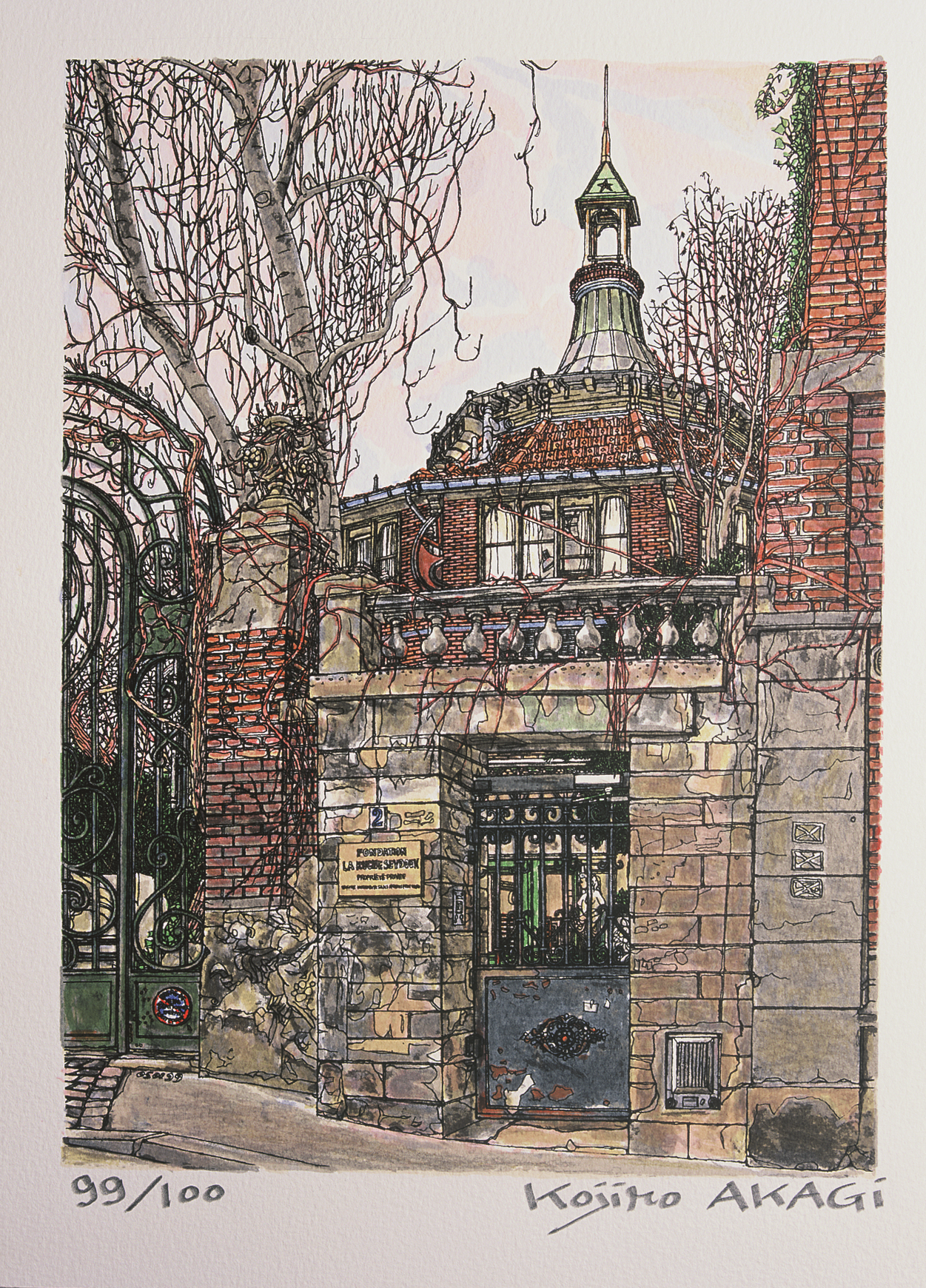Entrée de la Ruche / ラ・リューシュ
Dublin Core
タイトル (Title)
Entrée de la Ruche / ラ・リューシュ
テーマ (Subject)
Ruche, Lithographie
詳細 (Description)
Il s’agit de la Ruche des Abeilles. Conçu par les ateliers Eiffel, c’est un bâtiment de forme cylindrique qui fut le pavillon des vins de Bordeaux lors de l’Exposition universelle de 1900. Après cet événement, le sculpteur Alfred Bouchet l’a acheté puis déplacé ici à une époque où ce n’était que des terrains agricoles. Au milieu de cette structure entourée de champs, il a ajouté d’autres bâtiments et conçu de manière indépendante un village d’artistes. La sculptrice Camille Claudel y fait son apprentissage avec maître Bouchet avant de suivre Rodin. Au milieu du bâtiment cylindrique, un escalier donne sur chacun des quatre étages. Les appartements sont divisés en alvéoles, laissant imaginer que ces petites pièces forment une ruche. Au total, on comptait 80 ateliers de petite taille, mais au loyer modeste. Parmi les premiers locataires devenus célèbres, on compte Fernand Léger, Chagall, Zadkine, Modigliani et Soutine. Dans les années 60, il est envisagé de la détruire. En 1972, la société des HLM de Paris décide de racheter la Ruche pour être conservée et classée aux Monuments Historiques. Ces dernières années, pour garantir sa préservation, on ne peut plus y accéder librement. Le lieu est devenu un site touristique et certains viennent, un guide à la main, regarder à travers les grilles. Autrefois, on pouvait même visiter librement l’intérieur des bâtiments. Mais hélas, beaucoup de gens repartaient avec des objets pour garder un souvenir de leur visite. Il faut désormais s’adapter à un monde qui oblige à adopter ce type de mesures de protection.
This means a beehive. This is a cylindrical building designed by the factory of the group which built the Eiffel Tower as a wine pavilion of Bordeaux wines for the Paris Universal Exposition in 1900. After the Expo, Alfred Bouchet, a famous sculptor at that time, bought it and transferred it to the current site which was farmland at the time. He installed it in the centre, adding some atelier terraced houses and offered them as an artists’ village. The female sculptor Camille Claudel is also a disciple of this teacher Bouchet for her initial induction before starting to study under Rodin.The four-storied cylindrical building in the centre had winding stairs with the central pole as an axis and rooms like the segments of an orange, so the rooms were very small like honeycomb cells. Though they were small, they were rented cheaply and it is said they were divided into 80 ateliers in total. The painters who lived here in its early days and became famous are Léger, Chagall, Zadkine, Modigliani and Soutine. Though there was a plan to demolish it in the 1960s the public housing corporation for low income groups of Paris bought it and it was listed as a historical building in 1972 to be preserved.In recent years, it has become impossible to enter in safety but it is a tourist sight and there are many people who visit there on foot holding guidebooks to see it from outside, the iron gate being barred. Though it was possible to visit anywhere inside the building freely in the past, many people pocketed the parts of the building as souvenirs so some restrictions had to be put in place to protect the building. We now live in an age of tourists being a nuisance.
ミツバチの巣箱のことである。一九〇〇年のパリ万国博覧会に、ボルドーワインのワイン館としてエッフェル塔を建てたエッフェル社工場が設計の、円筒形の建物である。万博の後、アルフレッド・ブッシェーと呼ばれる、当時の有名彫刻家が引き取って、まだ農地だった現在の敷地に移転した。中心にすえ、幾棟かのアトリエ長屋も追加して、芸術家村として個人で提供したのである。女流彫刻家カミーユ・クローデルも、ロダンにつく前最初の手ほどきは、このブッシェー先生の弟子だった。中心の四階建ての円筒の建物は、真ん中の芯を階段にしてグルグル登り、ミカンの房みたいに仕切って部屋にしたから、とても小さな部屋で蜂の巣みたいだったのである。狭いけれど非常に安い家賃で提供し、全体で八十アトリエに分割されていたという。初期に入った画家で有名になったのは、フェルナン・レジエ、シャガール、ザッキン、モジリアニ、スーチンが、ここに住んだ。一九六〇年代取り壊す案も出たが、パリ低所得者用公団住宅会社が買い、一九七二年歴史建造物指定となって、保存されている。 用心のため、近年は自由に入れなくなってしまったが、観光の名所で、ガイドブックを片手に散歩に訪ねてきて、鉄格子の門の外から眺めてゆく人も多い。昔は建物の中まで、何処でも自由に訪れることが出来ていたが、スーブニールに建物の一部とか、記念品を持ち去る人が多く、自衛をせざるを得ない時世で、観光公害の世の中なのである。
制作者 (Creator)
Kojiro Akagi (1934-2021)
日付 (Date)
Mars 2007, March 2007
権利 (Rights)
Fonds de dotation Kojiro AKAGI
フォーマット (Format)
Sérigraphie, Atelier Del Arco, 100 tirages + 30 romain + 40 E.A. romain, sur papier Arches 32 x 42 cm.
タイプ (Type)
Lithographie
タグ
引用
Kojiro Akagi (1934-2021), “Entrée de la Ruche / ラ・リューシュ,” Kojiro Akagi - Fonds de dotation Kojiro AKAGI , accessed 2025年12月24日, https://kojiroakagi.com/gallery/items/show/117.

